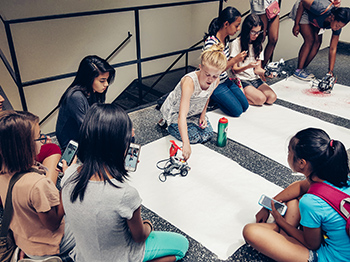Vida Winans, director of Illinois Tech’s Computer Discovery Camp for Middle School Girls, describes the evolution of the camp, which has doubled in enrollment since it was founded in 2010 and is now so popular that it has a waiting list.

I had been teaching computer science at Illinois Tech, and most of the students in my classes were male. Even now, it’s only about 24 percent women. As a member of the American Association of University Women, I also knew that a lot of girls turn away from math and science in middle school. So when Cindy Hood [associate professor of computer science and engineering] asked me what I’d like to do with a National Science Foundation grant, I knew I wanted to target middle school girls, to increase their interest and get them to the point to where they could say, “I can do it.”
When I first started the camp and was researching an age-appropriate curriculum, not a lot of materials were designed for girls of this age. In the past seven years, there has been an explosion on the web of materials to get students involved in science. At first they had no clue about binary or coding, and now girls have already been exposed through school. We are seeing a much more sophisticated level of preparation of the students coming in.
One of my students who started when she was in seventh grade has been helping me with the camp for the last several summers. She is now applying to colleges and thinking of combining computer science with medicine. Some of these girls now feel comfortable enough with computer science that they want to make it their career choice.
The projects are hands on. We use LEGO Mindstorms robot kits. Studies show that girls lag behind male counterparts in spatial ability. So the LEGO robots, which they have to build, make girls think about how things are positioned and strengthen their spatial skills. Sometimes we program robots to gather data or we use sensors to put robots through a maze. This summer we’ll build robots that can dance. We are also going to work with e-textiles, to make wearable, customized clothes. One day this will be mainstream—wearables, sensors, microprocessors—so I try to keep things current, because by the time these girls launch their careers it will be old hat.
I’ve had parents ask, “Can I come and join in?” It’s a lot of fun.
One thing I hear from the parents is that the girls go back to their schools and are much more confident because they have done tech. For the girls, it’s a great social bonding experience to find other girls who enjoy being techy. Often girls think at school that they can’t be excited about tech because their friends aren’t into it.
I hope girls who attend our camp will feel that they can, if they choose, do tech—whether that is engineering, computer science, or anything related to those fields—because I think that’s their biggest fear, that they can’t be good at it.
As a culture, as a society, we are teaching students more about computational thinking, trying to get them to learn it beginning in elementary school. Seeing that evolution has been exciting for me, and I hope we continue to encourage not just the girls but all students to try tech. That push is so important.
—As told to Chelsea Kalberloh Jackson